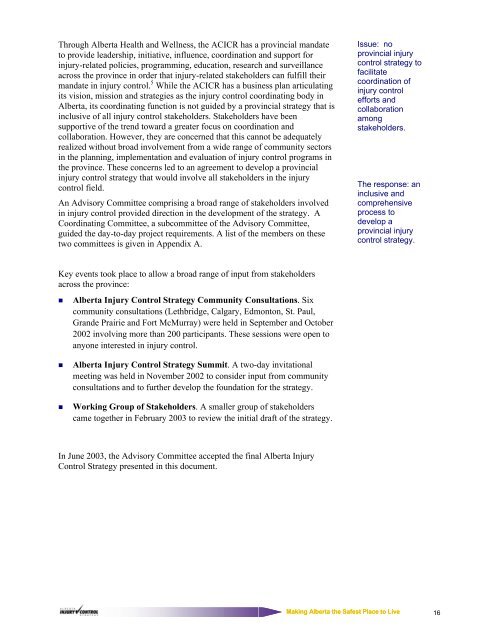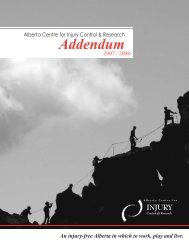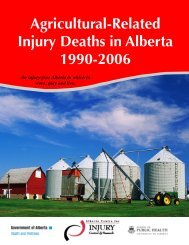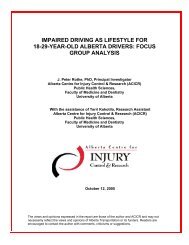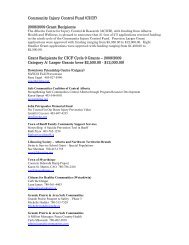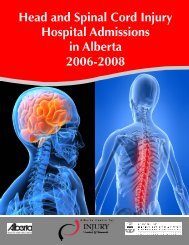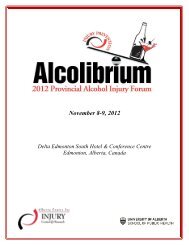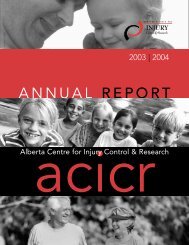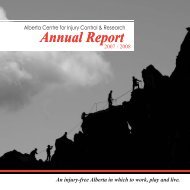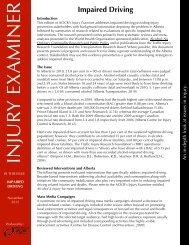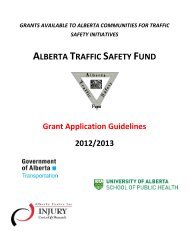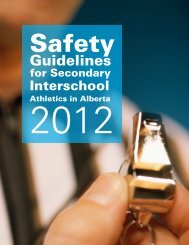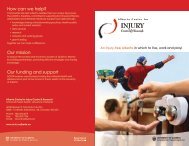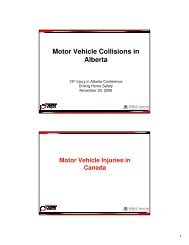JUNE 2003 - Alberta Centre for Injury Control & Research
JUNE 2003 - Alberta Centre for Injury Control & Research
JUNE 2003 - Alberta Centre for Injury Control & Research
Create successful ePaper yourself
Turn your PDF publications into a flip-book with our unique Google optimized e-Paper software.
Through <strong>Alberta</strong> Health and Wellness, the ACICR has a provincial mandate<br />
to provide leadership, initiative, influence, coordination and support <strong>for</strong><br />
injury-related policies, programming, education, research and surveillance<br />
across the province in order that injury-related stakeholders can fulfill their<br />
mandate in injury control. 5 While the ACICR has a business plan articulating<br />
its vision, mission and strategies as the injury control coordinating body in<br />
<strong>Alberta</strong>, its coordinating function is not guided by a provincial strategy that is<br />
inclusive of all injury control stakeholders. Stakeholders have been<br />
supportive of the trend toward a greater focus on coordination and<br />
collaboration. However, they are concerned that this cannot be adequately<br />
realized without broad involvement from a wide range of community sectors<br />
in the planning, implementation and evaluation of injury control programs in<br />
the province. These concerns led to an agreement to develop a provincial<br />
injury control strategy that would involve all stakeholders in the injury<br />
control field.<br />
An Advisory Committee comprising a broad range of stakeholders involved<br />
in injury control provided direction in the development of the strategy. A<br />
Coordinating Committee, a subcommittee of the Advisory Committee,<br />
guided the day-to-day project requirements. A list of the members on these<br />
two committees is given in Appendix A.<br />
Issue: no<br />
provincial injury<br />
control strategy to<br />
facilitate<br />
coordination of<br />
injury control<br />
ef<strong>for</strong>ts and<br />
collaboration<br />
among<br />
stakeholders.<br />
The response: an<br />
inclusive and<br />
comprehensive<br />
process to<br />
develop a<br />
provincial injury<br />
control strategy.<br />
Key events took place to allow a broad range of input from stakeholders<br />
across the province:<br />
• <strong>Alberta</strong> <strong>Injury</strong> <strong>Control</strong> Strategy Community Consultations. Six<br />
community consultations (Lethbridge, Calgary, Edmonton, St. Paul,<br />
Grande Prairie and Fort McMurray) were held in September and October<br />
2002 involving more than 200 participants. These sessions were open to<br />
anyone interested in injury control.<br />
• <strong>Alberta</strong> <strong>Injury</strong> <strong>Control</strong> Strategy Summit. A two-day invitational<br />
meeting was held in November 2002 to consider input from community<br />
consultations and to further develop the foundation <strong>for</strong> the strategy.<br />
• Working Group of Stakeholders. A smaller group of stakeholders<br />
came together in February <strong>2003</strong> to review the initial draft of the strategy.<br />
In June <strong>2003</strong>, the Advisory Committee accepted the final <strong>Alberta</strong> <strong>Injury</strong><br />
<strong>Control</strong> Strategy presented in this document.<br />
Making <strong>Alberta</strong> the Safest Place to Live<br />
16


